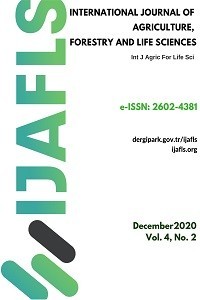Influence of culture media, temperature, pH and light regime on mycelial growth of Ascochyta rabiei
Influence of culture media, temperature, pH and light regime on mycelial growth of Ascochyta rabiei
Ascocyhta rabiei, Environmental factors Growth,
___
- Abubakar, A. Suberu, H.A. Bello, I.M. Abdulkadir, R. Daudu, O.A. Lateef, A. A. (2013). Effect of pH on mycelial growth and sporulation of Aspergillus parasiticus. J. Plant Sci., 1. 4: 64-67
- Attar, B. Ahmed, S. Kayim, M. Choueiri, E. Ghannam, H.A. Hamwieh, A. (2020). Role of sexual reproduction in the aggressivene.s of Didymella rabiei affecting chickpea. Arab. J. Plant Prot., 38.1: 17-24 https://dx.doi.org/10.22268/AJPP-38.1.010016
- Aveskamp, M.M. de Gruyter, J. Woudenberg, J.H.C. Verkley, G.J.M. Crous, P.W. (2010). Highlights of the Didymellaceae: a polyphasic approach to characterise Phoma and related Pleosporalean genera. Stud. Mycol., 65: 1-60 https://doi.org/10.3114/sim.2010.65.01
- Bahr, L. María Victoria Castelli, M.V. Barolo, M.I. Ruiz Mostacero, N. Tosello, M.E. López, S.N. (2016). Ascochyta blight: isolation, characterization, and development of a rapid method to detect inhibitors of the chickpea fungal pathogen Ascochyta rabiei. Fungal Biol., 120.3: 424-432 http://dx.doi.org/10.1016/j.funbio.2015.12.002
- Baite, M.S. Dubey, S.C. Singh, B. (2016). Morphological variability in the Indian isolates of Ascochyta rabiei causing blight in chickpea and evaluation of chickpea cultivars. Indian J. Plant Prot., 44.1: 74-82
- Basandri, A.K. Pande, S. Kishore, G.K. Crouch, J.H. Basandri, D. (2005). Cultural, morphological and pathological variation in Indian isolates of Ascochyta rabiei, the chickpea blight pathogen. Plant Pathol. J., 21.3:207-213 https://doi.org/10.5423/PPJ.2005.21.3.207
- Bayraktar, H. Ozer, G. Aydogan, A. Palacıoglu, G. (2016). Determination of Ascochyta blight disease in chickpea using Real-Time PCR. J. Plant Dis. Prot., 123.3: 109-117 https://doi.org/10.1007/s41348-016-0017-0
- Benzohra, I.E. Bendahmane, S.B. Benkada, M.Y. (2017). Effect of five temperature levels on mycelial growth and sporulation of Botrytis fabae, agent of chocolate spot on faba bean (Vicia faba L. Subsp. Major). American-Eurasian J. Agric. & Environ. Sci., 17.6: 530-535 DOI: 10.5829/idosi.aejaes.2017.530.535
- Deshmukh, A.J. Mehta, B.P. Sabalpara, A.N. Patil, V.A. (2012). In vitro effect of various nitrogen, carbon sources and pH regimes on the growth and sporulation of Colletotrichum gloeosporioides Penz. and Sacc causing anthracnose of Indian bean. J. Biopest, 5 (Supplementary): 46-49
- Duzdemir, Oral. Selvi, B. Yanar, Y. Yildirimi, A. (2014). Sources of resistance in chickpea (Cicer arietinum L.) land races against Ascochyta rabiei causal agent of Ascochyta blight disease. Pak. J. Bot., 46.4: 1479-1483
- Faostat 2019. The State of Food and Agriculture. Food and Agriculture Organization of the United Nations (FAO) http://www.fao.org/faostat/en/#data/QC (Accessed Date: 03.02.2021)
- Harveson, R.M. Markell, S.G. Goswami, R. Urrea, C.A. Burrows, M.E. Dugan, F. Chen, W. Skoglund, L.G. (2011).Ascochyta blight of chickpeas. Plant Health Progress, 12:1 https://doi.org/10.1094/PHP-2011-0103-01-DG
- Kaiser, W.J. (1973). Factors affecting growth, sporulation, pathogenicity, and survival of Ascochyta rabiei. Mycologia, 65.2: 444-457 https://doi.org/10.2307/3758115
- Kosiada, T. (2012). In vitro growth of some species of Ascochyta Lib. Cent. Eur. J. Biol., 7.6: 1076-1083 https://doi.org/10.2478/s11535-012-0095-3
- Ozkilinc, H. , Frenkel, O. Abbob, S. Eshed, R. Sherman, A. Shtienberg, D. Ophirc, R. C. Can, C. (2010). A comparative study of Turkish and Israeli populations of Didymella rabiei, the Ascochyta blight pathogen of chickpea. Plant Pathol., 59: 492–503 https://doi.org/10.1111/j.1365-3059.2009.02226.x
- Pande, S. Siddique, K.H. Kishore, G.K. Bayaa, B. Gaur, P.M. Gowda, C.L. Bretag, T.W. Crouch, J.H. (2005). Ascochyta blight of chickpea (Cicer arietinum L.): A review of biology, pathogenicity, and disease management. Aust. J. Agric. Res., 56.4: 317-332 https://doi.org/10.1071/AR04143
- Saha, A. Mandal, P. Dasgupta, S. Saha, D. (2008). Influence of culture media and environmental factors on mycelial growth and sporulation of Lasiodiplodia theobromae (Pat.) Griffon and Maubl. J. Environ. Biol., 29: 407-10 https://www.researchgate.net/publication/23440306
- Sharma, G. Pandey, R.R. (2010). Influence of culture media on growth, colony character and sporulation of fungi isolated from decaying vegetable wastes. J. Yeast Fungal Res.,1.8: 157-164 https://doi.org/10.5897/JYFR.9000029
- Trapero-Casas, A. Luque-Márquez, F. Kaiser, W.J. (2012). Development of the teleomorph of Ascochyta rabiei on culture media. Eur. J. Plant Pathol., 134: 773–782 https://doi.org/10.1007/s10658-012-0053-y
- Yayın Aralığı: Yılda 2 Sayı
- Başlangıç: 2017
- Yayıncı: Volkan OKATAN
Potential mechanisms of antioxidants derived from horticultural crops against covid-19
Ifeanyı Moses KANU, Austine Chukwukere OKEZİE
Economic Analysis of Thyme Production: A Case Study of Denizli Province, Turkey
Bahri KARLI, Zehra DEMİR, Mevlüt GÜL, Bektaş KADAKOĞLU
Fatma Gül GÖZE ÖZDEMİR, Şerife Evrim ARICI
Luka ANTHONY, Olugbenga ALABI, Elizabeth EBUKİBA, Gamba VANDİ
Determination of Fat, Fatty Acids and Tocopherol Content of Several Turkish Walnut Cultivars
Mesut ADA, Aibibula PAIZILA, Ömer Faruk BİLGİN, Şule Hilal ATTAR, Nurgül TÜREMİŞ, Salih KAFKAS, Ebruyasakafkas@gmail.com KAFKAS
Ecological Aspects of Allelopathy
Influence of culture media, temperature, pH and light regime on mycelial growth of Ascochyta rabiei
